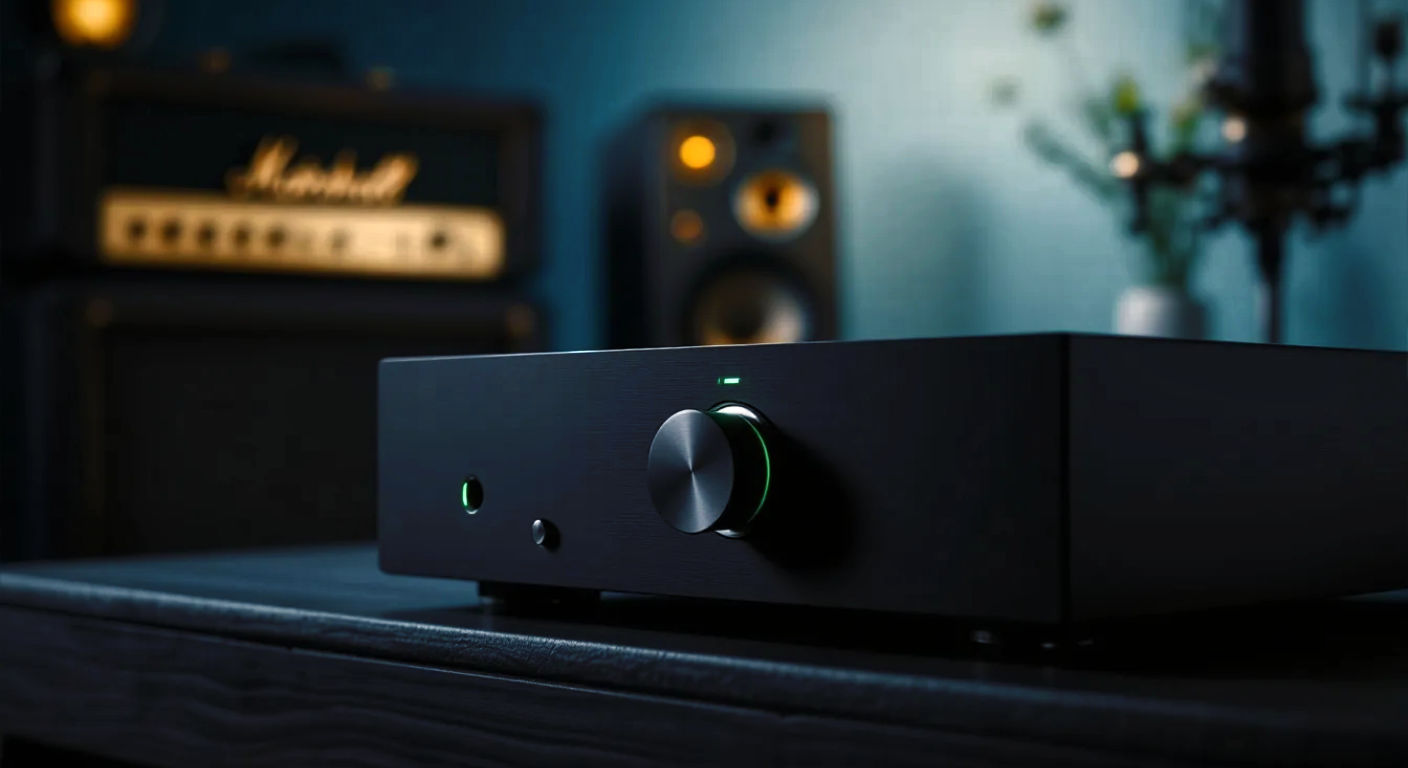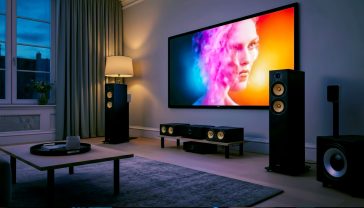Amplifiers: The Unsung Heroes Behind Every Great British Sound
The definitive guide to audio amplifiers. Discover how they work, the story of valve vs. solid-state, and the iconic British brands that shaped rock and hi-fi.

This post may contain affiliate links. If you make a purchase through these links, we may earn a commission at no additional cost to you.
Ever stood in a field, the bass from the Pyramid Stage at Glastonbury thumping in your chest? Or maybe you’ve been lost in a soaring guitar solo from a classic rock anthem, the sound so clear it feels like the musician is right there in the room with you. Perhaps you’ve simply sat at home, captivated by the rich, warm voice of a narrator in a David Attenborough documentary.
What connects all these moments? An amplifier.
It’s a piece of kit that most of us take for granted, humming away quietly in the background. But without it, the world of sound would be a very quiet place indeed. An amplifier is the engine of audio, the powerhouse that takes a tiny, whisper-quiet electrical signal and transforms it into something that can fill a stadium, shake a room, or bring a tear to your eye. It’s the heart of every hi-fi system, every guitar rig, and every concert PA system.
And Britain? Well, we’ve played a rather special role in this story. From the booming sound of the Swinging Sixties to the refined precision of modern high-end audio, British engineers and innovators have consistently been at the forefront, shaping the very way we hear the world. This is the story of the amplifier—a journey from a scientific curiosity to the beating heart of modern music and sound, with a distinctly British accent.
What on Earth Is an Amplifier, Anyway?
Before we dive into the deep end with tales of rock gods and audio wizards, let’s get the basics sorted. What does an amplifier actually do?
Imagine you’re trying to have a chat with a friend across a massive, bustling playground. If you whisper, they won’t hear a thing. You need to shout to make your voice carry over the noise. In a nutshell, an amplifier is a megaphone for an electrical signal.
The Simplified Explanation:
An audio signal, whether it’s from a microphone, a turntable, or your phone, starts life as a very weak electrical ripple. It’s far too feeble to move the cones in a loudspeaker and make a sound we can hear. The amplifier’s job is to take this tiny signal and make a much bigger, more powerful copy of it—all without changing its original shape. It’s like tracing a tiny drawing onto a huge piece of paper with a much thicker pen. The picture is the same, but now it’s big enough for everyone to see.
The More Detailed Explanation:
An amplifier works by using a small input signal to control a much larger power supply. Think of it like a tap. The small input signal is your hand turning the tap handle, and the big gush of water from the mains is the power supply. A tiny turn of the handle can release a huge amount of water. In an amp, the tiny electrical signal from your music source controls a flow of electricity from the wall socket. This flow is shaped into an exact, but much more powerful, replica of the original signal. This beefed-up signal is then sent to the speakers, where it has the muscle to physically move the speaker cones back and forth, creating the sound waves that travel to your ears. The magic lies in making this copy as perfect as possible, a process that has obsessed engineers for over a century.
A Journey Through Time: How the Amplifier Was Born
The story of the amplifier doesn’t start in a recording studio or a rock club. It begins in a laboratory, with scientists trying to solve a very different problem: how to send messages across vast distances.
The Dawn of the Valve: The Audion
In the early 1900s, radio was the new frontier. The challenge was that radio signals became incredibly weak as they travelled through the air. In 1906, an American inventor named Lee de Forest created something that would change everything: the Audion. This was the first practical device that could amplify an electrical signal.
The Audion was a type of thermionic valve (or “vacuum tube” in America). It looked a bit like a lightbulb, with a vacuum-sealed glass tube containing a few metal parts. It worked by heating a piece of metal (the cathode) so that it released a stream of electrons. A small voltage on a little wire grid could control this powerful stream of electrons. A tiny signal on the grid could create a huge change in the flow of electrons—and just like that, amplification was born.
Initially, its main use was in long-distance telephone calls and radio receivers. But it wasn’t long before people realised that if you could amplify a radio signal, you could amplify any signal. The door to a world of audible sound was creaking open.
The Golden Age of Valves
From the 1920s to the 1950s, the valve reigned supreme. The technology improved rapidly. Companies like Western Electric in the US and Britain’s own Marconi-Osram Valve (MOV) company developed more powerful and reliable valves. This was the era that gave us the first electronic musical instruments, public address (PA) systems, and, crucially, the beginning of the home audio system, or “hi-fi.”
British audio pioneers like Peter Walker, who founded Quad in 1936, and Harold Leak, founder of LEAK in 1934, were obsessed with creating amplifiers that could reproduce music with stunning realism. Their valve amplifiers from this period are now legendary. They produced a sound that many people describe as warm, rich, and musical. It wasn’t perfectly accurate, but it was beautiful. This “valve sound” is still loved by audiophiles and guitarists today. For many, it’s the audio equivalent of a cosy fireside chat – comforting, familiar, and deeply human.
The Transistor Revolution: A British Invasion
The valve had a good run, but it had its problems. Valves were big, fragile, got incredibly hot, and used a lot of power. The future was going to be smaller, cooler, and more efficient. The future was the transistor.
Invented at Bell Labs in America in 1947, the transistor did the same job as a valve but using a tiny sliver of “solid-state” material, usually silicon. It was a game-changer. By the late 1950s and early 1960s, transistors were becoming cheap and reliable enough to be used in consumer electronics.
This is where the British story really kicks into high gear. While valve amps were great for the gentle sounds of classical music and jazz, a new generation of musicians was making a much bigger noise. Rock ‘n’ roll was here, and it needed to be loud.
The Birth of the Beast: The Marshall Stack
In a small music shop in Hanwell, London, a drum teacher named Jim Marshall listened to the complaints of young guitarists like Pete Townshend of The Who. They wanted amps that were louder, tougher, and had a specific kind of raw, distorted sound when pushed hard.
Working with his engineer Dudley Craven, Jim Marshall created what would become an icon: the Marshall JTM45 amplifier in 1962. It was based on an American Fender amp, but Marshall’s team used different components available in Britain, which gave it a more aggressive, crunchy tone. This was the sound of rock. When paired with its towering speaker cabinets, it created the legendary “Marshall Stack,” a visual and sonic symbol of rock rebellion that has graced stages with everyone from Jimi Hendrix to Oasis. Marshall wasn’t just an amplifier; it was a cultural statement.
At the same time, another British company, Vox, was making its mark. Their AC30 amplifier, with its distinctive chimey sound, became the voice of the “British Invasion,” used by bands like The Beatles, The Kinks, and The Rolling Stones. The sound of Swinging London was the sound of British-made amplifiers.
How Amplifiers Work: A Peek Under the Bonnet
So, we know what an amplifier does, but how does it do it? Let’s lift the lid and explore the different “flavours” of amplifier design. The main way we categorise them is by their “class.” This isn’t about social standing; it’s about how the internal transistors or valves handle the musical signal.
Amplifier Classes Explained
Imagine you have a team of two workers whose job is to push and pull a swing to match a pattern you give them. The pattern is the musical signal.
- Class A: In this setup, both workers are pushing and pulling the swing all the time, even when the swing is meant to be still. They work together, one pushing a bit less while the other pulls a bit more.
- The Good: This is the purest, most accurate way to do it. The movement is smooth and there’s no handover point where things can go wrong. This is why many high-end audiophile amps are Class A. The sound is often described as incredibly detailed and sweet.
- The Bad: It’s wildly inefficient. The workers get very hot and tired because they are always working at full tilt, even when there’s no music playing. Class A amps guzzle electricity and produce a huge amount of heat. They are big, heavy, and expensive.
- Class B: Here, you have one worker who only pushes, and another who only pulls. They take turns.
- The Good: It’s much more efficient. The workers only work when they need to, so they don’t use as much energy or get as hot.
- The Bad: There’s a messy handover point in the middle where the “push” worker stops and the “pull” worker starts. This creates a tiny glitch in the swing’s motion every single time it passes the middle. This is called “crossover distortion,” and it sounds awful. Because of this, pure Class B amps are almost never used in audio.
- Class AB: This is the clever compromise and by far the most common type of amplifier. It works like Class B, but both workers are kept working just a tiny little bit all the time, right around the middle point.
- The Good: It eliminates that nasty crossover distortion while keeping most of the efficiency of Class B. It’s the perfect middle ground, offering great sound quality without needing its own postcode and power station. Most hi-fi and guitar amps you’ll come across are Class AB.
- Class D: This is a completely different approach. It’s the new kid on the block, often (and slightly inaccurately) called a “digital amplifier.”
- How it works: Instead of making a bigger copy of the smooth, wavy audio signal, a Class D amp chops it up into thousands of tiny rectangular pulses of different widths. It’s a bit like digital code. A powerful but simple switch turns on and off very quickly to create these pulses. A filter at the end smooths these pulses back out into a powerful audio wave.
- The Good: It’s incredibly efficient (often over 90%). This means Class D amps can be very small, light, and run cool, yet produce enormous amounts of power.
- The Bad: Early designs could sound harsh and brittle. However, the technology has improved massively. Today, modern Class D amps can sound fantastic and are found everywhere—in high-end hi-fi, car audio systems, powered speakers, and bass guitar amps.
The Great Debate: Valves vs. Solid-State
For decades, this has been the big argument in audio circles. It’s like asking a car enthusiast to choose between a classic, handcrafted Morgan and a modern, super-efficient Tesla. Both will get you there, but the experience is totally different.
- Valves (Thermionic Tubes):
- The Sound: Proponents love the “warm,” “rich,” and “three-dimensional” sound. When a valve amp is pushed hard, it distorts in a way that many people find musically pleasing. It adds gentle, even-order harmonics, which are related to the original note and can sound like it’s making the music richer. This is why so many guitarists still swear by them. A Marshall valve amp on the edge of breakup is the holy grail for many rock players.
- The Downsides: They are fragile, have a limited lifespan, consume a lot of power, and need to warm up. They are, in many ways, an objectively worse technology. But music isn’t always about objectivity.
- Solid-State (Transistors):
- The Sound: Solid-state amps are generally more accurate, powerful, and reliable. They deliver a clean, precise, and controlled sound with a powerful, tight bass. They aim for pure fidelity—to amplify the signal with as little colouration as possible. This is the goal for most modern hi-fi. British brands like Naim and Rega are masters of creating incredibly engaging and rhythmic solid-state amplifiers.
- The Downsides: When a solid-state amp distorts, it does so harshly, creating odd-order harmonics that clash with the music and sound very unpleasant. Critics sometimes describe their sound as “cold” or “sterile” compared to valves, though this is a huge generalisation.
Which is better? There’s no right answer. It comes down to personal taste and what you’re using it for. For the raw, organic roar of an electric guitar, many would say valves are unbeatable. For a crystal-clear reproduction of a delicate orchestral piece, a high-quality solid-state amp might be the better choice.
The Modern British Amplifier: Precision and Passion
While the thundering Marshall stacks defined one era of British sound, another, more subtle revolution was taking place in the world of home hi-fi. Starting in the 1970s, a new wave of British companies began to challenge the idea that good audio had to come from Japan or America.
These companies championed a “sound first” philosophy. They weren’t interested in adding lots of flashy features like tone controls and graphic equalisers. Their focus was on preserving the rhythm, timing, and emotional core of the music.
- Naim Audio (founded 1973, Salisbury): Naim became famous for its minimalist, “black box” amplifiers that focused on something they called “PRaT” – Pace, Rhythm, and Timing. A Naim amp doesn’t just play the notes; it captures the infectious, foot-tapping energy of the performance. It’s a sound that gets your head nodding.
- Rega (founded 1973, Essex): Best known for their turntables, Rega also makes brilliant amplifiers that share the same philosophy: simple, high-quality engineering that delivers maximum musical enjoyment for the money. Their Brio amplifier has been a go-to choice for budget-conscious audiophiles for decades.
- Cyrus (founded 1983, Cambridgeshire): Instantly recognisable by their unique half-width shoebox-sized casing, Cyrus amps pack a huge, dynamic, and incredibly detailed sound into a small package. They are renowned for their precision and clarity.
These brands, and others like Arcam and Musical Fidelity, created the blueprint for the modern British hi-fi sound: detailed, rhythmic, and intensely musical. They proved that you don’t need a wall of glowing valves to connect with your favourite artists.
Practical Advice: Choosing the Right Amplifier for You
Okay, enough history and theory. You want to buy an amplifier. The market can be a confusing place, full of jargon and technical specs. Here’s a simple guide to help you navigate it.
Step 1: What Are You Using It For?
This is the most important question.
- For a Hi-Fi System (listening to music): You’ll be looking for an integrated amplifier. This is a single box that combines the pre-amplifier (which handles input switching and volume control) and the power amplifier (which does the heavy lifting). It’s the simplest and most common solution.
- For an Electric Guitar or Bass: You need a dedicated guitar amplifier or bass amplifier. These are very different beasts from hi-fi amps. They are designed to be part of the instrument’s sound, adding character, tone, and distortion. They often come as a “combo” (amplifier and speaker in one box) or a “head and cabinet” (separate boxes).
- For a Home Cinema: You’ll need an AV Receiver (AVR). This is a multi-channel amplifier that can power five, seven, or even more speakers for surround sound. It also acts as the central hub for all your video sources (like a Blu-ray player or games console).
Step 2: Power – How Much Do You Need?
Power is measured in Watts per channel (WPC). It’s easy to get obsessed with this number, but it’s not the whole story.
- The Room: A bigger room needs more power to fill it with sound.
- The Speakers: This is the crucial bit. Every speaker has an efficiency rating (measured in decibels, dB). A speaker with high efficiency needs less power to get loud than one with low efficiency. A 3dB increase in efficiency is like doubling your amplifier’s power!
- Your Listening Habits: Do you listen quietly in the background, or do you like to feel the bass in your bones?
For a typical British living room with reasonably efficient speakers, an amplifier with 30-60 watts per channel is usually more than enough. Don’t be fooled by cheap amps claiming hundreds of watts; it’s the quality of the watts that counts, not the quantity.
Step 3: Connections – What Do You Need to Plug In?
Think about all the things you want to listen to.
- Turntable (Record Player): If you have a turntable, you might need an amplifier with a built-in phono stage. This is a special extra bit of amplification needed for the very tiny signal from a record player’s cartridge. If the amp doesn’t have one, you can buy an external one.
- Digital Sources (CD player, Streamer, TV): You’ll need digital inputs, like optical or coaxial. Many modern amps also have a USB input for connecting a computer.
- Wireless (Phone, Tablet): Bluetooth is a common feature for easy wireless streaming. For better quality, look for amps with built-in Wi-Fi streaming capabilities (e.g., Spotify Connect, Tidal Connect, AirPlay).
Step 4: Have a Listen!
This is the most important rule. You can read reviews and spec sheets all day, but the only way to know if you’ll like an amplifier is to hear it. If you can, visit a local hi-fi dealer. Take your own speakers or listen with speakers similar to yours. Most importantly, take your favourite music. Does it make you want to dance? Does it give you goosebumps? That’s the one for you. An amplifier is an investment in your enjoyment, so trust your own ears.
The Future of Amplification: Smaller, Smarter, and Everywhere
The humble amplifier has come a long way from Lee de Forest’s glowing glass bulb. So, what’s next?
- The Rise of Class D: The efficiency and power of Class D technology will continue to dominate. Amps will get smaller and more powerful, disappearing into the back of speakers or becoming tiny boxes that can power an entire system.
- Digital Integration: The line between an amplifier and a computer is blurring. Future amps will be sophisticated digital hubs, packed with powerful Digital Signal Processing (DSP). DSP can correct for the acoustic problems in your room, optimise the sound for your specific speakers, and provide a level of control we could only dream of a few years ago.
- Active Speakers: Increasingly, the amplifier will move inside the loudspeaker itself. These are called active speakers. Each speaker driver (e.g., the tweeter for high sounds and the woofer for low sounds) gets its own dedicated amplifier channel, perfectly optimised for its job. This is a technically superior solution that offers incredible performance and simplicity.
- Gallium Nitride (GaN): This is a new type of semiconductor material that is starting to replace silicon in high-end Class D amplifiers. It allows for even faster and more efficient switching, pushing sound quality to new heights.
The amplifier isn’t going away. It’s just getting smarter and changing its shape. It is becoming the invisible, intelligent heart of our audio world, working silently to connect us to the music and sounds we love. From the raw power of a Marshall stack to the precise rhythm of a Naim integrated, the amplifier is a testament to over a century of innovation, a story in which Britain has played a starring, and very loud, role.
Further Reading
For those looking to explore this topic in greater detail, we highly recommend the following respected resources:
- What Hi-Fi?: A leading UK-based publication for hi-fi reviews and advice.
- Sound on Sound: An authoritative magazine focusing on music production and recording technology.
- The National Valve Museum: An incredible online resource detailing the history of thermionic valves.
- Audio Science Review: A forum for in-depth technical analysis and objective measurements of audio equipment.






